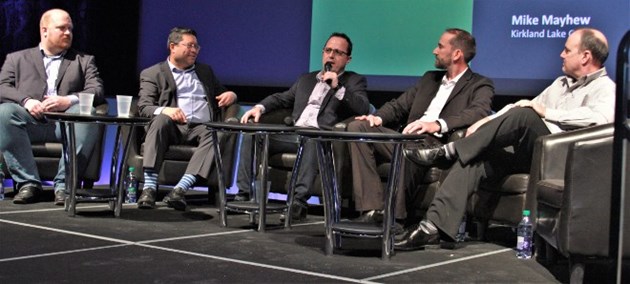Panel of experts talking future and challenges of emerging technology brought a packed house to the Sudbury CIM general membership meeting at Science North.
Jan 21, 2019 7:00PM by:

From left, Maarten van Koppen, Raphael Tiangco, Mike Mayhew, Brian Huff and Shane Wisniewski were the members of a panel discussion on battery electric vehicles for the monthly meeting of the Sudbury chapter of the Canadian Institute of Mining. (Karen McKinley photo)
The transition to battery electric vehicles in mining is well underway, but there remain technology issues that need to be addressed, said a panel of industry leaders in Sudbury, Jan.17.
The discussion on electric vehicles brought a packed house to the Sudbury chapter of the Canadian Institute of Mining's monthly general meeting at Science North.
The panel included Shane Wisniewski, general manager of mining projects at Glencore; Brian Huff, chief technology officer of Artisan Vehicles; Mike Mayhew, mine superintendent of Kirkland Lake Gold; Raphael Tiangco, superintendent of mobile fleet management at Vale; and Maarten van Koppen, senior project engineer at Goldcorp.
The panellists agreed that battery technology is the way of the future for deep hardrock mining, citing everything from cost savings and durability to health and safety.
Tiangco related his experiences underground when diesel was the dominant energy source.
“I'd come up, and blow my nose, and it was black," he said. "You don't get that with electric because there are no emissions."
What was worse, he added, was that the particulate had been the cause of countless cancer and respiratory problems for career miners.
There are issues plaguing battery technology; mainly heat, duration of charge, conversion of existing diesel vehicles, and some safety issues.
Van Koppen, who admitted he was sceptical about battery technology at first, feels it's very safe now, with many internal systems to monitor the internal workings for heat, current, and damage.
“Compare that to a diesel tank, which has no internal monitors."
Using a rock truck as an example, van Koppen said once converted to battery, it has the running equivalent of about seven and a half megawatt-hours.
The downside, he said, is that workers need more training to understand how the technology works and what repairs they can do safely. However, workers have embraced the vehicles on several projects.
Mayhew said since they brought battery electric vehicles to Macassa Mine in Kirkland Lake, workers much preferred them over diesel.
Another concern is charge life.
Huff said Artisan and the industry are trying to come up with solutions to extend battery life to hold charges longer under tough conditions, such as making it easier to switch out batteries for faster turnaround. Recharging can take up to two hours.
“There's a long-term goal of about 15 minutes (for charge time), where battery swapping can happen in less than 10,” Huff said, “and the amount of heat generated is much less.”
The problem facing engineers with faster charging is heat. Doubling the current produces eight times the heat.
To increase the current even eight times to shorten a battery charge from two hours to 15 minutes would produce 64 times the heat, creating problems for safety and damage. It also requires more copper, adding to the cost.
That means designing machines around those limitations.
There have been advances in redirecting energy lost in operations, such as redirecting energy from braking, and calculating potential energy during work to extend a battery's life.
The mining companies that currently still use diesel will eventually have to transition their fleets.
Tiangco said there is no set timeline, but Vale is currently using electric vehicles in situations where it makes economic sense, especially in underground areas where there are ventilation constraints.
The company will gradually introduce them in those areas as learning opportunities to better understand where these vehicles can be applied elsewhere.
The availability of these vehicles for Vale to procure is another constraint.
Tiangco said when it's time to do wholesale fleet changes, they will “set the table” with their providers to ensure the transition can be done quickly.
Overall, the positives outweigh the negatives as the technology progresses and it's adopted by more mining companies.
With adoption comes more collaboration between companies in working together to find solutions to improve efficiencies.
The elimination of diesel fuel and oil was one example van Koppen used when talking about Goldcorp's Borden Gold Mine, near Chapleau, which uses battery electric vehicles.
While he was there in 2016, there were numerous concerns raised by Borden Lake residents and First Nations about diesel spills and noise. Battery vehicles are much quieter.
“We are practically invisible,” he said. “Some residents told us they can hear humming and scraping of gravel, but no engine noise. It becomes pretty appealing.”
Source linked from NORTHERN ONTARIO Business https://www.sudbury.com/local-news/battery-electric-in-mining-here-to-stay-1206218
